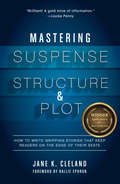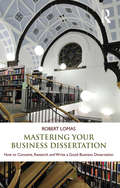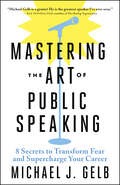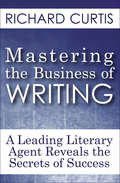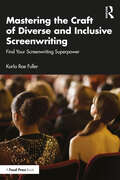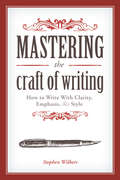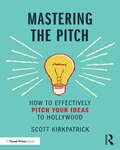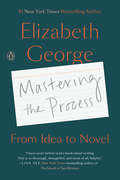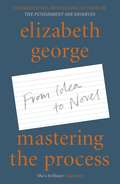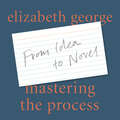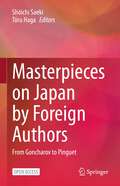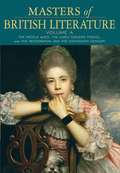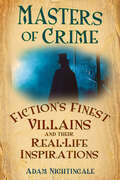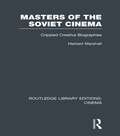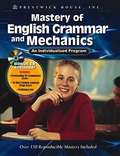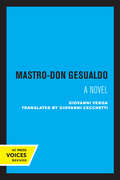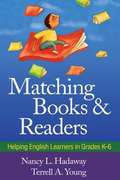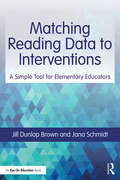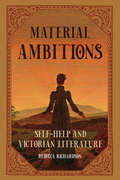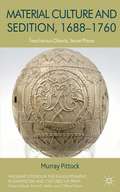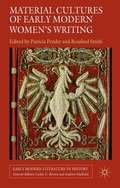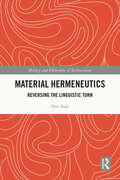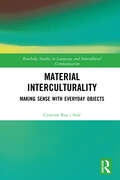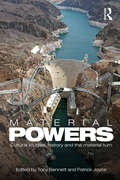- Table View
- List View
Mastering Suspense, Structure, and Plot: How to Write Gripping Stories That Keep Readers on the Edge of Their Seats
by Jane ClelandEnthrall Your Readers! Suspense is one of the most powerful tools a writer has for captivating readers--but it isn't just for thrillers. From mainstream fiction to memoir, suspense creates the emotional tension that keeps readers on the edge of their seats. Mastering Suspense, Structure, & Plot is your hands-on guide to weaving suspense into your narrative. Award-winning author Jane K. Cleland teaches you how to navigate genre conventions, write for your audience, and build gripping tension to craft an irresistible page-turner. Inside, Cleland will show you how to:Implement thirteen no-fail techniques to construct an effective plot and structure for your storyUse Cleland's Plotting Road Map to add elements of suspense like twists, reversals, and moments of dangerWrite subplots with purposeImprove your descriptions, character development, sentence structure, and morePacked with case studies, exercises, and dozens of examples from best-selling authors, Mastering Suspense, Structure, & Plot is the key to writing suspenseful, engaging stories that leave your readers wanting more. ------ "Indispensable! For newbie authors and veterans alike, this terrific how-to is your new go-to. Don't write your book without it--it's a treasure." --Hank Phillippi Ryan, Agatha, Anthony, Macavity and Mary Higgins Clark award-winning author
Mastering Your Business Dissertation: How to Conceive, Research and Write a Good Business Dissertation (Routledge Companions In Business, Management And Accounting Ser.)
by Robert LomasThe ability to write to a high standard is a key skill that is often overlooked in the business world. This short book from an international, best-selling author offers a practical guide to conceiving, researching and writing a business or management dissertation. Robert Lomas offers an inspirational treatise that will awaken the quest for knowledge among his readership. The book helps business students to frame their research questions in a more helpful manner in order to achieve their research aims and write in a clear and top scoring way. Topics covered include collecting and measuring data, using business statistics, planning research projects and the real mechanics of writing a dissertation. Masters students across business and management will benefit enormously from reading this book, not just in adding serious value to their dissertations, but also helping to improve their writing skills throughout their business careers. This book includes a foreword by Mark Booth.
Mastering the Art of Public Speaking: 8 Secrets to Transform Fear and Supercharge Your Career
by Michael J. GelbSeventy-four percent of Americans suffer from glossophobia, the fear of public speaking. In fact, even top professional speakers and accomplished actors experience butterflies before presenting. They never eliminate the butterflies; they just teach them how to fly in formation. How? Michael Gelb&’s techniques will help you clarify and shape your message so that your audience — no matter how big or small, in person or virtual — will care about it. Once the message is clear, he teaches you how to convey it in memorable, creative, and effective ways. Gelb shows that public speaking is a skill anyone can learn and enjoy. Mastering the Art of Public Speaking will guide you to rediscover your natural gift for communication while strengthening confidence and presence.
Mastering the Business of Writing: A Leading Literary Agent Reveals the Secrets of Success
by Richard CurtisOne of the most comprehensive guides currently on the market, MASTERING THE BUSINESS OF WRITING is an insider's guide to the business of being a professional writer. All aspects of the publishing industry are explained, both for the aspiring author and the established writer wishing to jump start a professional career. This guide includes everything you need to know about publishers, agents, and the track to success, including: What agents do and how they develop relationships within the publishing industry that can be beneficial to your career; the best way to formulate a book proposal that sells; what publishers are really looking for in a book—and what they aren't; understanding technicalities of advances, contracts, multibook deals and subsidiary rights; the significance of sales conferences and bookstore chains; essential manners and protocols for establishing positive relations with your agent, editor and publisher, legal issues, copyright, and much, much more....
Mastering the Craft of Diverse and Inclusive Screenwriting: Find Your Screenwriting Superpower
by Karla Rae FullerThis accessible and informative textbook provides a guide to the craft of screenwriting with an emphasis on diverse perspectives, underrepresented groups and their screen stories. Readers will learn to master writing a feature-length screenplay in a framework that focuses on diversity, equity and inclusion. With case studies to aid understanding, the book explores the screenwriting process in stages, explaining how to create a logline, as well as character bios, writing and choosing a genre, differentiating between writing a treatment, a synopsis, composing an outline, incorporating the formatting process and finally creating a scene and sequence. The techniques specific to screenwriting will also be covered in the text such as writing dialogue and action, establishing setting and time period and most importantly mastering the craft of visual storytelling. At the same time, the textbook introduces concepts of content choices that are diverse and inclusive, such as stereotypes vs. archetypes, intersectional characters, underrepresented groups and themes such as social justice, systemic racism, class conflict, gender inequity and climate change.Due to its subject matter and inclusive approach, this textbook will be an essential guide for all aspiring and current screenwriters who want to successfully navigate and complement today’s developing industry.
Mastering the Craft of Writing: How to Write With Clarity, Emphasis, and Style
by Stephen WilbersMake Every Word Memorable! To be remembered for your words, you need to write with skill and style. Whether you're crafting a novel, composing an e-mail, or creating a technical report, Mastering the Craft of Writing presents 52 practical techniques to improve your prose. Spend a week with each technique, or use this book as a go-to reference. Either way, you'll have the tools to enliven your writing and delight your readers. Write with economy: Eliminate wordiness, use strong verbs to drive your sentences, and don't trust modifiers. Write with emphasis: Use punctuation for effect, structure sentences and paragraphs for coherency and flow, and employ repetition to make your point. Write with distinction: Use your imagination to create the unexpected, add a light-hearted touch to your writing, and go beyond clarity to eloquence and grace. With exercises, entertaining asides, and a wealth of useful information, Mastering the Craft of Writing is an invaluable resource for any writer. Once you master these techniques, you'll want to use them in everything you write.
Mastering the Pitch: How to Effectively Pitch Your Ideas to Hollywood
by Scott KirkpatrickTold from the perspective of a Hollywood executive with nearly 20 years’ experience professionally pitching and distributing film/TV projects, Mastering the Pitch reveals all the nuanced details of the pitching process. Readers will gain valuable insights into how the Hollywood system operates, improve their professional pitching skills and gain a competitive edge in getting their ideas from concept to greenlight. This book covers: how projects are packaged and developed before a pitch; how a pitch presentation happens in a real-world setting; the core concepts required to pitch each genre type; how professional companies actually acquire a pitched project; the legal workflows and financial details required to put a deal together; examples of pitch documents, presentation materials and how these elements should be designed; how to build your personal brand so that you’re seen by Hollywood decision makers as someone capable of delivering great projects; and how you should speak to professionals about the business viability of your projects Mastering the Pitch is a valuable crossover text, designed to help both students and veteran film/TV producers alike hone their pitching and presentation skills.
Mastering the Process: From Idea to Novel
by Elizabeth GeorgeAs the author of twenty-four novels, Elizabeth George is one of the most successful--and prolific--novelists today. In Mastering the Process, George offers readers a master class in the art and science of crafting a novel. This is a subject she knows well, having taught creative writing both nationally and internationally for over thirty years."I have never before read a book about writing that is so thorough, thoughtful, and most of all, helpful." --Lisa See, New York Times bestselling author of The Island of Sea WomenFor many writers, the biggest challenge is figuring out how to take that earliest glimmer of inspiration and shape it into a full-length novel. How do you even begin to transform a single idea into a complete book? In these pages, award-winning, number one New York Times bestselling author Elizabeth George takes us behind the scenes through each step of her writing process, revealing exactly what it takes to craft a novel.Drawing from her personal photos, early notes, character analyses, and rough drafts, George shows us every stage of how she wrote her novel Careless in Red, from researching location to imagining plot to creating characters to the actual writing and revision processes themselves. George offers us an intimate look at the procedures she follows, while also providing invaluable advice for writers about what has worked for her--and what hasn't. Mastering the Process gives writers practical, prescriptive, and achievable tools for creating a novel, editing a novel, and problem solving when in the midst of a novel, from a master storyteller writing at the top of her game.
Mastering the Process: From Idea to Novel
by Elizabeth George'After a number of years teaching writing courses and appearing at writers' conferences, I began to see that creating a process book utilising one of my novels as an example of each step of my process might prove useful to people who are interested in novel writing or in how this individual writer approaches the complicated task of putting together a British crime novel.'As the author of twenty-four novels, Elizabeth George is one of the most successful - and prolific - novelists today. In Mastering the Process, George offers a master class in the art and science of crafting a novel, sharing her wealth of experience with would-be novelists, and with crime fiction fans. Using her actual work to illustrate the various steps of novel writing that she explores in this book, she illustrates her points about plotting, characterisation and technique with great clarity and generosity.Drawing from her personal photos, early notes, character analyses, and rough drafts for every stage of her novel Careless in Red, George offers us an intimate look at the procedures she follows, from researching location to imagining plot to creating characters to the actual writing and revision processes themselves. At the same time, she gives invaluable advice for writers about what has worked for her - and what hasn't. Mastering the Process provides writers with practical, prescriptive, and achievable tools for creating a novel, editing a novel, and problem solving when in the midst of a novel, from a master storyteller at the top of her game.Elizabeth George has taught creative writing both nationally and internationally for over thirty years and is the author of Write Away, described as 'one novelist's approach to fiction and the writing life'.
Mastering the Process: From Idea to Novel
by Elizabeth George'After a number of years teaching writing courses and appearing at writers' conferences, I began to see that creating a process book utilising one of my novels as an example of each step of my process might prove useful to people who are interested in novel writing or in how this individual writer approaches the complicated task of putting together a British crime novel.'As the author of twenty-four novels, Elizabeth George is one of the most successful - and prolific - novelists today. In Mastering the Process, George offers a master class in the art and science of crafting a novel, sharing her wealth of experience with would-be novelists, and with crime fiction fans. Using her actual work to illustrate the various steps of novel writing that she explores in this book, she illustrates her points about plotting, characterisation and technique with great clarity and generosity.Drawing from her personal photos, early notes, character analyses, and rough drafts for every stage of her novel Careless in Red, George offers us an intimate look at the procedures she follows, from researching location to imagining plot to creating characters to the actual writing and revision processes themselves. At the same time, she gives invaluable advice for writers about what has worked for her - and what hasn't. Mastering the Process provides writers with practical, prescriptive, and achievable tools for creating a novel, editing a novel, and problem solving when in the midst of a novel, from a master storyteller at the top of her game.Elizabeth George has taught creative writing both nationally and internationally for over thirty years and is the author of Write Away, described as 'one novelist's approach to fiction and the writing life'.(P) 2020 Penguin Random House Audio
Masterpieces on Japan by Foreign Authors: From Goncharov to Pinguet
by Shōichi Saeki Tōru HagaThis open access book includes forty-one chapters about foreign observers’ discourses on Japan. These include a wide range of perspectives from the travelogues of curious visitors to academic theses by scholars, which offer us a broad spectrum of contents, reflecting a variety of attitudes toward Japan. The works were written during the period from the 1850s to the 1980s, a timespan during which Japan became, in stages, more open to the outside world after a long isolation under the Tokugawa shogunate. From the perspective of “Japanology,” one can discern three distinct periods of rising interest in the country from abroad. The first tide of such interest came shortly after the opening of Japan, when various foreign travelers, including those who could not be included in this book, came over and wrote down their impressions of the country—which was, for them, a land of mystery and mystique, which had just opened its doors to them. The second wave arose at the beginning of the twentieth century, just after the Russo-Japanese War, when Japan again generated a remarkable surge of interest as a “miracle” in Asia that had pulled off the wondrous feat of defeating a white superpower. The third wave was more recent, which took place from the late 1960s to the 1980s, a period of high economic growth when the “miracle” of Japan’s remarkable economic recovery from the defeat of World War II attracted enthusiastic and curious attention from the outside world once again. It is not the intention of this book to directly highlight such historical transitions, but these forty-two brilliant mirrors (forty-one chapters, including forty-two discourses), even when looked in casually, provide us with unexpected insights and various perspectives. Shōichi Saeki (1922–2016) was Professor Emeritus, the University of Tokyo. Tōru Haga (1931–2020) was Professor Emeritus, International Research Center for Japanese Studies.
Masters of British Literature, Volume A
by David Damrosch Kevin J. H. Dettmar Peter J. Manning Susan J. Wolfson Heather Henderson William Chapman Sharpe Jennifer Wicke Christopher Baswell Clare Carroll Constance Jordan Stuart Sherman Anne Howland SchotterWritten by an editorial team whose members are all actively engaged in teaching and in current scholarship, Masters of British Literature is a concise, yet comprehensive survey of the key writers whose classic works have shaped British literature. Featuring major works by the most influential authors in the British literary tradition-Chaucer, Spenser, Shakespeare, Sidney, Donne, Milton, Behn, Swift, Pope, Johnson-this compact anthology offers comprehensive coverage of the enduring works of the British literary tradition from the Middle Ages through the Restoration and the eighteenth century. Core texts are complemented by contextual materials that help students understand the literary, historical, and cultural environments out which these texts arose, and within which they find their richest meaning.
Masters of British Literature, Volume B
by David Damrosch Kevin J. H. Dettmar Peter J. Manning Susan J. Wolfson Heather Henderson Jennifer Wicke Christopher Baswell Clare Carroll Constance Jordan Stuart ShermanWritten by an editorial team whose members are all actively engaged in teaching and in current scholarship, Masters of British Literature is a concise, yet comprehensive survey of the key writers whose classic works have shaped British literature. Featuring major works by the most influential authors in the British literary tradition--Barbauld, Blake, Wollstonecraft, Wordsworth, Coleridge, Keats, Barrett Browning, Browning, Tennyson, Yeats, Woolf, Joyce, Eliot, Walcott, Heaney, and Rushdie--this compact anthology combines comprehensive coverage of the enduring works of the British literary tradition from the Romantics through the twentieth century. Core texts are complemented by contextual materials that help students understand the literary, historical, and cultural environments out which these texts arose, and within which they find their richest meaning.
Masters of Crime: Fiction's Finest Villains and Their Real-Life Inspirations
by Adam NightingaleThis fascinating volume reveals the real men – and women – behind some of the most infamous London villains ever to appear in fiction. Fagin, Professor Moriarty, Moll Cutpurse and the notorious 'cracksman' A.J. Raffles were all rooted in the lives and deaths of a litany of real-life criminals, agitators and activists. With a special emphasis on the city that spawned them, this book brings together their stories for the first time, and shows how they were woven into fiction by some of Britain’s greatest writers, including Charles Dickens and Arthur Conan Doyle. Containing prison escapes, sensational trials, daring art thefts, vicious attacks, roaring boys, black magicians and private detectives, Masters of Crime explores both the real underworld of British crime history, and its fictional counter-parts. It will delight fans of true crime and crime fiction alike.
Masters of the Soviet Cinema: Crippled Creative Biographies (Routledge Library Editions: Cinema)
by Herbert MarshallEisenstein, Pudovkin, Dovzhenko, Vertov: these Soviet film directors are acknowledged to be among the greatest in the history of cinematography. To Eisenstein we owe such films as Battleship Potemkin and October; to Pudovkin Mother and The End of St Petersburg; to Dovzhenko Earth and Zvenigora; and to Vertov The Man With a Movie Camera and The Three Songs of Lenin. Herbert Marshall knew each of them personally, both as artists and as friends, and shared their cinema world when he was a student at the GIK (The Moscow State Institute of Cinematography) in the heady years following the Revolution into the period of the first Five Year Plan. His material is culled from personal recollections, diaries, notes, unpublished and published biographies, letters, press cuttings, articles and books in various languages, but mainly from Soviet sources and the Soviet cinema world. Taking the subjects one by one, this indispensible book discusses their major films including an account of their creation and reception in the USSR and abroad. It shows the tragedy of these four Soviet artists who were lucky enough not to be arrested or deprived of their limited freedom, yet who nevertheless ended up with ‘crippled creative biographies’. The author then examines the changed viewpoint in the climate of 1983 when the book was originally published.
Mastery of English Grammar and Mechanics: An Individualized Program
by Prestwick House IncA language arts textbook. Identify and correct grammar and mechanics problems quickly and efficiently with Mastery of Grammar and Mechanics: An Individualized Program. <P><P>Twelve of the most troubling areas for students, such as showing possession, subject/verb agreement, and using proper punctuation, are clearly explained in brief, targeted lessons with multiple practice exercises and a mastery test for each lesson.
Mastro-Don Gesualdo: A Novel
by Giovanni VergaThis title is part of UC Press's Voices Revived program, which commemorates University of California Press’s mission to seek out and cultivate the brightest minds and give them voice, reach, and impact. Drawing on a backlist dating to 1893, Voices Revived makes high-quality, peer-reviewed scholarship accessible once again using print-on-demand technology. This title was originally published in 1979.
Matching Books and Readers
by Nancy Hadaway Terrell YoungProviding practical guidance and resources, this book helps teachers harness the power of children's literature for developing ELLs' literacy skills and language proficiency. The authors show how carefully selected fiction, nonfiction, and poetry can support students' learning across the curriculum. Criteria and guiding questions are presented for matching books and readers based on text features, literacy and language proficiency, and student background knowledge and interests. Interspersed throughout are essays and poems by well-known children's authors that connect in a personal way with the themes explored in the chapters. The annotated bibliography features over 600 engaging, culturally relevant trade titles.
Matching Reading Data to Interventions: A Simple Tool for Elementary Educators
by Jill Dunlap Brown Jana SchmidtThis accessible and reader-friendly book will help you assess and determine the foundational reading needs of each of your K – 5 students. Literacy leaders Jill Dunlap Brown and Jana Schmidt offer an easy-to-use data analysis tool called, "The Columns" for teachers at all levels of experience to make sense of classroom data for elementary readers. This book will guide you in using the tool to identify the root causes of foundational reading deficits and to plan appropriate interventions. Sample case studies allow you to practice identifying needs and matching interventions. Stories and examples throughout the book will encourage you as you help your students meet their full potential. The book provides easy-to-use and printable versions of the data analysis columns that will enable you to put the authors‘ advice into immediate action. These tools are available for download on the book’s product page: www.routledge.com/9780367225070
Material Ambitions: Self-Help and Victorian Literature
by Rebecca RichardsonWhat the Victorian history of self-help reveals about the myth of individualism.Stories of hardworking characters who lift themselves from rags to riches abound in the Victorian era. From the popularity of such stories, it is clear that the Victorians valorized personal ambition in ways that previous generations had not. In Material Ambitions, Rebecca Richardson explores this phenomenon in light of the under-studied reception history of Samuel Smiles's 1859 publication, Self-Help: With Illustrations of Character, Conduct, and Perseverance. A compilation of vignettes about captains of industry, artists, and inventors who persevered through failure and worked tirelessly to achieve success in their respective fields, Self-Help links individual ambition to the growth of the nation. Contextualizing Smiles's work in a tradition of Renaissance self-fashioning, eighteenth-century advice books, and inspirational biography, Richardson argues that the burgeoning self-help genre of the Victorian era offered a narrative structure that linked individual success with collective success in a one-to-one relationship. Advocating for a broader cultural account of the ambitious hero narrative, Richardson argues that reading these biographies and self-help texts alongside fictional accounts of driven people complicates the morality tale that writers like Smiles took pains to invoke. In chapters featuring the works of Harriet Martineau, Dinah Craik, Thackeray, Trollope, and Miles Franklin, Richardson demonstrates that Victorian fiction dramatized ambition by suggesting where it runs up against the limits of an individual's energy and ability, where it turns into competition, or where it risks upsetting a socio-ecological system of finite resources. The upward mobility plots of John Halifax, Gentleman or Vanity Fair suggest the dangers of zero-sum thinking, particularly evidenced by contemporary preoccupations with Malthusian and Darwinian discourses. Intertwining the methodologies of disability studies and ecocriticism, Material Ambitions persuasively unmasks the longstanding myth that ambitious individualism can overcome disadvantageous systematic and structural conditions.
Material Culture And Sedition, 1688–1760
by Murray PittockMaterial Culture and Sedition, 1688-1760 is a groundbreaking study of the ways in which material culture (and its associated designs, rituals and symbols) was used to avoid prosecution for treason and sedition in the British Isles. The fresh theoretical model it presents challenges existing accounts of the public sphere and consumer culture.
Material Cultures of Early Modern Women’s Writing
by Patricia Pender Rosalind SmithThis collection examines the diverse material cultures through which early modern women's writing was produced, transmitted, and received. It focuses on the ways it was originally packaged and promoted, how it circulated in its contemporary contexts, and how it was read and received in its original publication and in later revisions and redactions.
Material Hermeneutics: Reversing the Linguistic Turn (History and Philosophy of Technoscience)
by Don IhdeMaterial Hermeneutics explores the ways in which new imaging technologies and scientific instruments have changed our notions about ancient history. From the first lunar calendar to the black hole image, and from an ancient mummy in the Italian Alps to the irrigated valleys of Mesopotamia, this book demonstrates how revolutions in science have taught us far more than we imagined. Written by a leading philosopher of technology and utilizing an interdisciplinary approach, this book has implications for many fields, including philosophy, history, science, and technology. It will appeal to scholars and students of the humanities, as well as anthropologists and archaeologists.
Material Interculturality: Making Sense with Everyday Objects (Routledge Studies in Language and Intercultural Communication)
by Cristina Ros i SoléThis book shows how objects can create new linguistic and cultural orders, spotlighting the ways in which everyday collections help make the world anew by rearranging its materiality and how multilingual speakers make meanings without words.Adopting an innovative approach to intercultural research drawing on work from visual and multisensorial ethnography, Ros i Solé critically reflects on what we know as interculturality by going beyond the verbal and the more-than-human to understand languages and cultures. This book expands the meaning of interculturality by seeing it as the result of the relations between people, places, and materiality. Using everyday multilingual artefacts such as clothes, cookie-cutters, LPs, books, and pens, it presents a new semiotic multilingual landscape where the intercultural is closely connected to the ground, and it is felt, rehearsed, and re-enacted through the stories and the memories contained in multilingual objects.This book will be of particular interest to students and scholars in intercultural communication, multilingualism, language education, and applied linguistics.
Material Powers: Cultural Studies, History and the Material Turn (CRESC)
by Tony Bennett Patrick JoyceThis edited collection is a major contribution to the current development of a ‘material turn’ in the social sciences and humanities. It does so by exploring new understandings of how power is made up and exercised by examining the role of material infrastructures in the organization of state power and the role of material cultural practices in the organization of colonial forms of governance. A diverse range of historical examples is drawn on in illustrating these concerns – from the role of territorial engineering projects in seventeenth-century France through the development of the postal system in nineteenth-century Britain to the relations between the state and road-building in contemporary Peru, for example. The colonial contexts examined are similarly varied, ranging from the role of photographic practices in the constitution of colonial power in India and the measurement of the bodies of the colonized in French colonial practices to the part played by the relations between museums and expeditions in the organization of Australian forms of colonial rule. These specific concerns are connected to major critical re-examination of the limits of the earlier formulations of cultural materialism and the logic of the ‘cultural turn’. The collection brings together a group of key international scholars whose work has played a leading role in debates in and across the fields of history, visual culture studies, anthropology, geography, cultural studies, museum studies, and literary studies.
